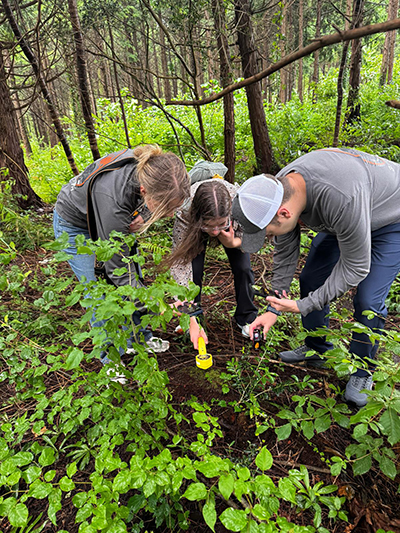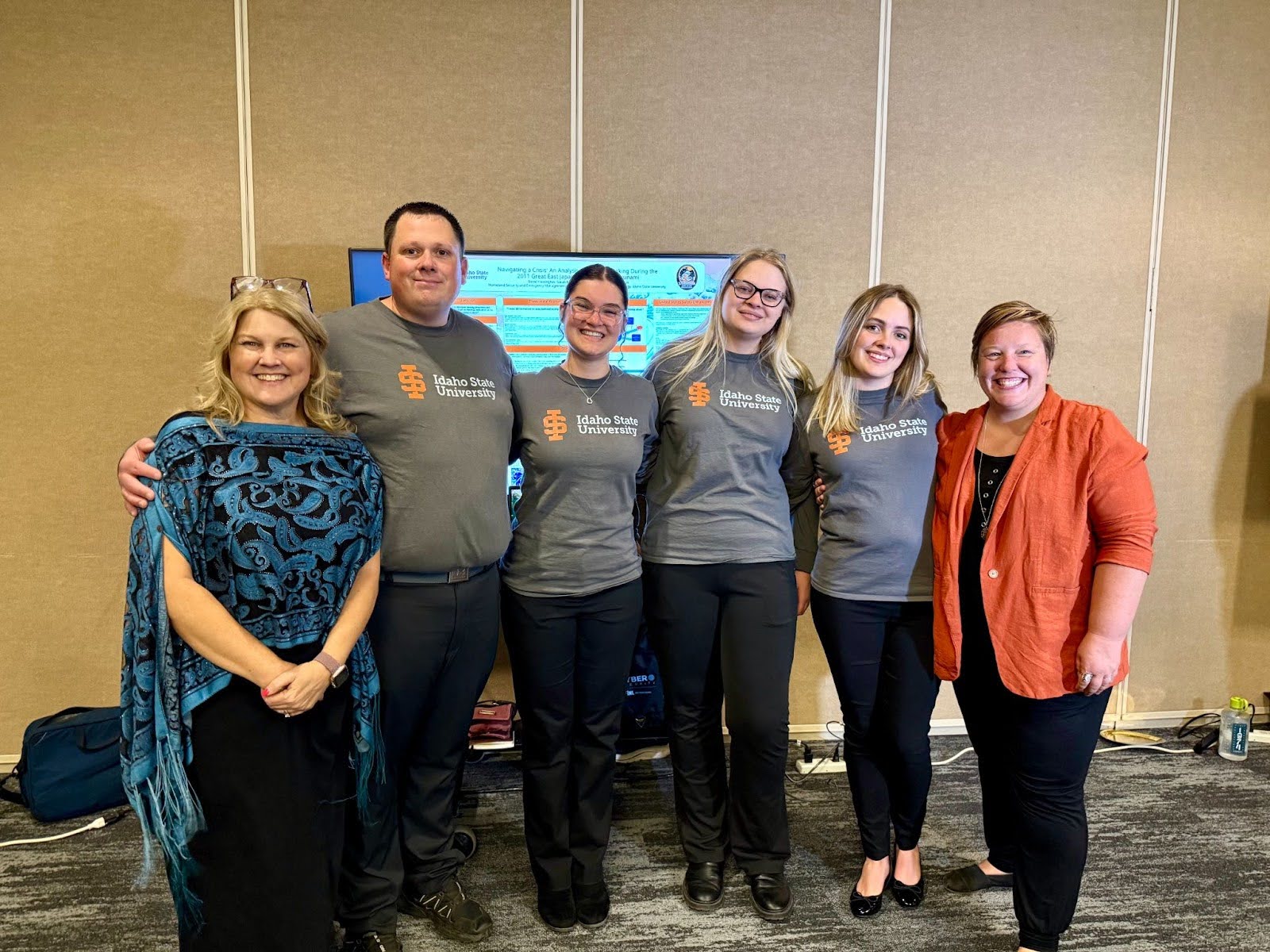ISU Students Travel to Japan to Study Nuclear Disaster Response on the Ground
August 14, 2025
The next generation of nuclear operations and emergency management professionals are entering the workforce with unmatched, hands-on experiences through Idaho State University.
This summer, students from across campus traveled to Fukushima, Japan as part of a groundbreaking interdisciplinary course exploring nuclear accident management and emergency response. The course is titled Case Study in Nuclear Emergency Response and Management: Fukushima.
The classroom and research abroad experience included students in the College of Technology’s Energy Systems Technology and Education Center (ESTEC) nuclear operations program, the College of Health’s homeland security and emergency management (HSEM) program, and the College of Science and Engineering’s health physics, civil engineering, and nuclear engineering programs
Led by Mackenzie Gorham, ESTEC program coordinator and clinical senior instructor, and Laurie Holien, clinical professor and director of the HSEM program and director of the Institute of Emergency Management, the course provided students with a rare, first-hand opportunity to apply lessons from one of the most significant nuclear disasters in recent history.
The course offered an in-depth look at the 2011 triple disaster, including the Fukushima Dai-Ichi Nuclear Power Plant accident, triggered by the Great Tohoku earthquake and tsunami. Through a combination of classroom instruction and an immersive faculty-led trip to Japan, students explored real-world nuclear safety practices and emergency response strategies. The multidisciplinary course, cross-listed for both undergraduate and graduate students, encouraged collaboration across academic backgrounds, enhancing students’ understanding of both their own specialties and how they fit into a broader coordinated response.
The Japan trip, held July 11–19, served as the course’s centerpiece. Students worked in cross-disciplinary groups, gaining diverse perspectives through collaborative learning. They toured the TEPCO Fukushima Dai-Ichi plant and observed the state-of-the-art cleanup operations, learning directly from officials involved in the region's recovery. In the still-uninhabitable Fukushima exclusion zone, students used advanced radiation instruments—donated by Tom Clausen of TRG Inc. in Idaho Falls and ISU Radiation Safety—to conduct hands-on assessments and monitoring. This endorsement from industry underscores the strength and relevance of the educational approach led by Gorham and Holien meant to prepare students for their future.

Reflecting on the trip, Daniel De La Rosa, a student in the HSEM program reached out to Gorham and Holien to share his appreciation and describe the course’s impact on his academic journey.
“This research course was such a meaningful experience for me. Traveling to Japan and conducting a case study on the Fukushima disaster gave me insight I never expected to gain in a college course. It really opened my eyes to new ways of thinking and helped me grow both personally and academically,” said De La Rosa. “What stood out most was that this wasn’t just a class, it was a full experience. Working as a team, learning about a new culture, and connecting with others through research was something special. I hope this course continues for future students, because it truly has the power to impact lives. Thank you both for your time, guidance, and the opportunity to be part of something so valuable. It’s motivated me to stay focused on my goals and continue pushing forward in my education.”
“Even after extensive research preparation, conversations with affected individuals and TEPCO workers (both current and former) revealed layers of meaning no document could capture,” said Miranda Kriner, a ESTEC graduate and a current health physics and HSEM masters student. “Our fieldwork in Japan underscored that engaging with lived experiences is essential to truly understanding and preparing for any disaster.”
The itinerary also emphasized mitigation efforts, crisis decision-making, and emergency response missions. At Tokyo's Renkai Disaster Prevention Park, students experienced the aftermath of a simulated earthquake, search and rescue operations, and sheltering requirements following disaster scenarios. Cultural immersion was equally prioritized, as students participated in a Japanese cultural orientation and resided in the rehabilitated areas within Fukushima that were once part of the exclusion zone. Evacuation returnees shared perspectives on the evacuation and their lives after the accident recovery work began, and how the accident still impacts them today. These candid conversations offered deeply personal insight into life after a nuclear disaster. Students also met with national news media to better understand disaster communication.
“This was a once-in-a-lifetime trip. I was told we were some of the last people able to see reactor 1 before it was covered for decommissioning,” said Cody Nave, an HSEM undergraduate student. “Meeting Izawa-san, the shift supervisor on duty during the disaster, was eye-opening. Hearing his story put me in the heart of the event. I'm very grateful for this unique and enlightening experience that will help me in my future career.”
This trip transformed classroom knowledge into real-world application and gave students the opportunity to thoughtfully reflect on how they might respond in their future careers. This was demonstrated when five research teams, composed of cross-disciplinary students, presented posters and presentations during a Research Symposium on July 31, with one team preparing to submit their work to a peer-reviewed journal. In the nuclear energy and emergency response industry, studying past lessons is essential, as the field places exceptional emphasis on safety—contributing to its standing as one of the safest forms of energy.

Gorham and Holien aim to make trips like this, to a variety of destinations, a recurring opportunity every two years and are actively pursuing grants to ensure the continuation of this invaluable experience.
“Experiences like this not only advance industry standards but also deepen students’ sense of responsibility and commitment,” said Gorham. “By engaging directly with the people and places affected by a nuclear event, rather than relying solely on textbook studies, students gain a profound understanding of the real-world impact of their work and the importance of maintaining the highest safety standards.”
By combining rigorous technical education with immersive, real-world international experience, ISU’s College of Technology, College of Science and Engineering and Kasiska Division of Health Sciences are positioning graduates to lead the way in nuclear safety and emergency management.
For more information about the programs involved, visit these websites.
College of Technology Energy Systems Nuclear Operations Technology
College of Health Homeland Security and Emergency Management
College of Science and Engineering Nuclear Engineering
Categories:
College of Health ProfessionsCollege of Science and EngineeringCollege of TechnologyGraduate SchoolResearchUniversity News
